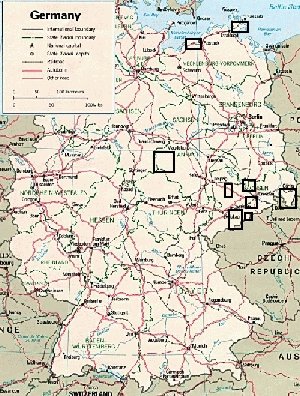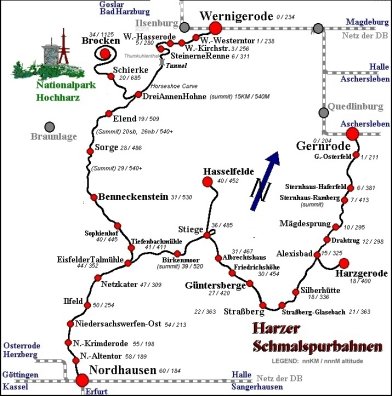![]()
The Harz Mountain Railway - text courtesy of John Craft (SteamCentral)


Maps also courtesy of John Craft of Steam Central
The HSB is actually the merger of two private railways built at the turn of the century: the Nordhausen-Wernigerode Eisenbahn, comprising the Wernigerode-Nordhausen line and the Brocken line, and the Gernrode-Harzgerode Eisenbahn, constructed from Gernrode to Eisfelder Talmuhle, with branches to Harzgerode (opened 1888) and Hasselfelde (opened 1892). On April 6, 1946, Soviet Troops began disassembling the Gernrode - Stiege portion of the line. The rails and rolling stock were sent to Russia in order to fulfill reparation demands. The Soviet Administration soon found out that this was a mistake, as raw material transports were almost impossible afterwards. They ordered relaying rails in late 1946. Traffic between Gernrode, Harzgerode and Strassberg started again in 1949 with rolling stock from the Harzquerbahn. The branch Eisfelder Talmuhle - Hasselfelde was assigned to the Harzquerbahn. It was not until 1983 when the 14 km gap Strassberg - Stiege was reconstructed. The Nordhausen-Wernigerode Eisenbahn (NWE) and Gernroder-Harzgeroder Eisenbahn (GHE) were nationalized in 1949 and incorporated in the GDR public railroad system Deutsche Reichsbahn During the Cold War and partition of Germany, the East-West border ran across the summit of the Brocken, the area's highest peak, where a Russian listening post was established. Since the railway spirals around the mountain (thereby crossing from East to West twice), the Schierke - Brocken section was closed to passenger traffic in the years leading up to reunification.
The first train to Brocken in many years operated on 30 April 1990, where a garrison of Russian soldiers looked out at the "Wessies" (west Germans) streaming off the train. After long discussions with environmentalists who wanted the Brocken to be off-limits; for the public in order to preserve vulnerable flora, regular service to the Brocken resumed on July 1, 1992 - after replacing rotten rails and roadbed.
The line was privatised in 1990 as part of preparing the Deutsches Reischebahn for merger with the Deutsche Bundesbahn. Service cutbacks and operating philosophy changes clouded the line's future for most of the decade as a more commercial mindset developed, different schedules were tried, threats of abandonment and the end of steam were staved off, and a stable operation slowly emerged. A visitor in the early 90s would have found far more service on the Gernrode-Eisfelder Talmuhle section than exists today, and many of the trains to Drei Annen Hohne would have been diesel-powered.
In 1995, as subsidies began to disappear and tourism was increasing, the decision was made to run all Wernigerode-Drei Annen Hohne-Brocken trains with steam power, and at least one steam-powered train on most of the remaining sections of the railway. Trains where steam power is normally dispatched are shown as such in the railway's timetables. Sadly, the daily simultaneous departures from Eisfelder Tal muhle (one train to Benneckenstein, one to Stiege) are only performed for photo specials. One can still catch them at Alexisbad, but not normally with two steam-powered trains. Recently steam service out of Gernrode has increased, with additional turns to Alexisbad and a return of regular steam trains to Hasselfelde. Only the Eisfelder Talmuhle - Stiege section does not see a daily steam-powered train. The network's home is in Wernigerode, a small industrial town about 90 miles southeast of Hannover. The railway maintains an engine shed, a small yard, and a workshop here. Engines are also assigned to Nordhausen and Gernrode. Engine sheds still exist at Ilfeld, Benneckenstein, and Hasselfelde, and are used to store unneeded power. Most trains are powered by one of 12 2-10-2Ts built between 1954 and 1956. (Another six are in storage.) There's also a collection of eight older, historic locomotives used as backup power and for special trains. 99.5901 - 99.5903, 0-4-4-0Ts built as NWE 11-13 in 1897 and 1898 are complemented by 99.5906, a military-issue cousin built in 1918. Two military 0-6-0Ts from 1914, a 2-6-2T from 1939, and a Fairlie. (NWE 11 and 13, 99.5906, 99.6001, and 99.6102 are serviceable.)
Home | Links | History | Sitelist | Photo's
I am very grateful to John Craft for generous permission to copy material from his Harz Page on SteamCentral